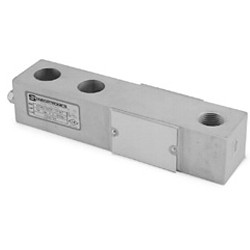One question that we received recently was “what capacity of load cell is inside your standard 4×4 5K floor scale”? The answer to that question is; normally you would see (4) 2.5K capacity shear beam load cells used in most 48″ x 48″ 5000 pound capacity industrial floor scales. Occasionally, you might see (4) of the 4K capacity load cells used in a rough environment.

One similar note to think about is how you load the 4×4 platform scale. No matter what load cell(s) you have underneath, the manner in which a load is positioned upon a scale’s weighing surface can impact scale performance and longevity. Most scales are designed to weigh a widely dispersed load. For example, a 4×4 floor scale can repeatedly weigh pallets because the load is spread out across a wide surface area. However, the same weight contained on a pallet can produce a much different result if it is not dispersed. If placed on a tote with casters, for example, the load creates focused points (rather than a dispersed load) upon the weighing surface. This is known as point loading.
Repetitive, near-capacity point loading, can damage a scale’s physical integrity. A floor scale’s top plate may begin to warp at point loading locations, eventually leading to scale failure. If you know that you’re going to be point loading, we can have our suppliers build custom scales specifically designed for point loading. Featuring a thicker top plate, these scales can withstand non-dispersed loads.
Common applications include:
• Containers on wheels
• Pallet jacks
• Forklifts
• Repetitive weighing patterns or “traffic lanes”
Prior to selecting a scale, make sure you are aware of how you intend to use it. You may not be aware that you’re actually in a point loading application. Understanding day-to-day weighing habits will help ensure you receive the scale best suited to your application. Be sure to communicate that to your purchasing department and to your scale company that you’re working with to make certain you get the proper product for your weighing needs.